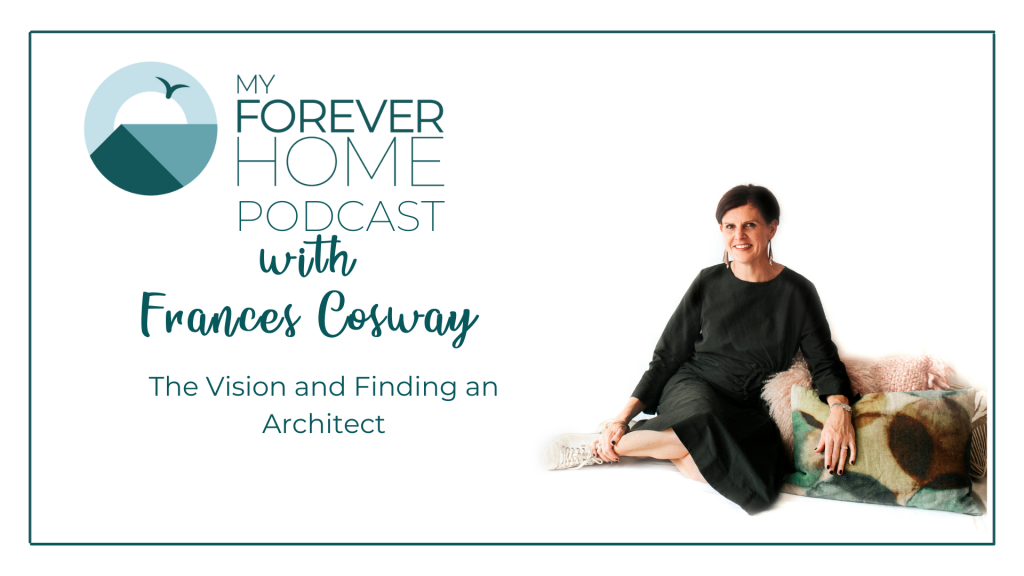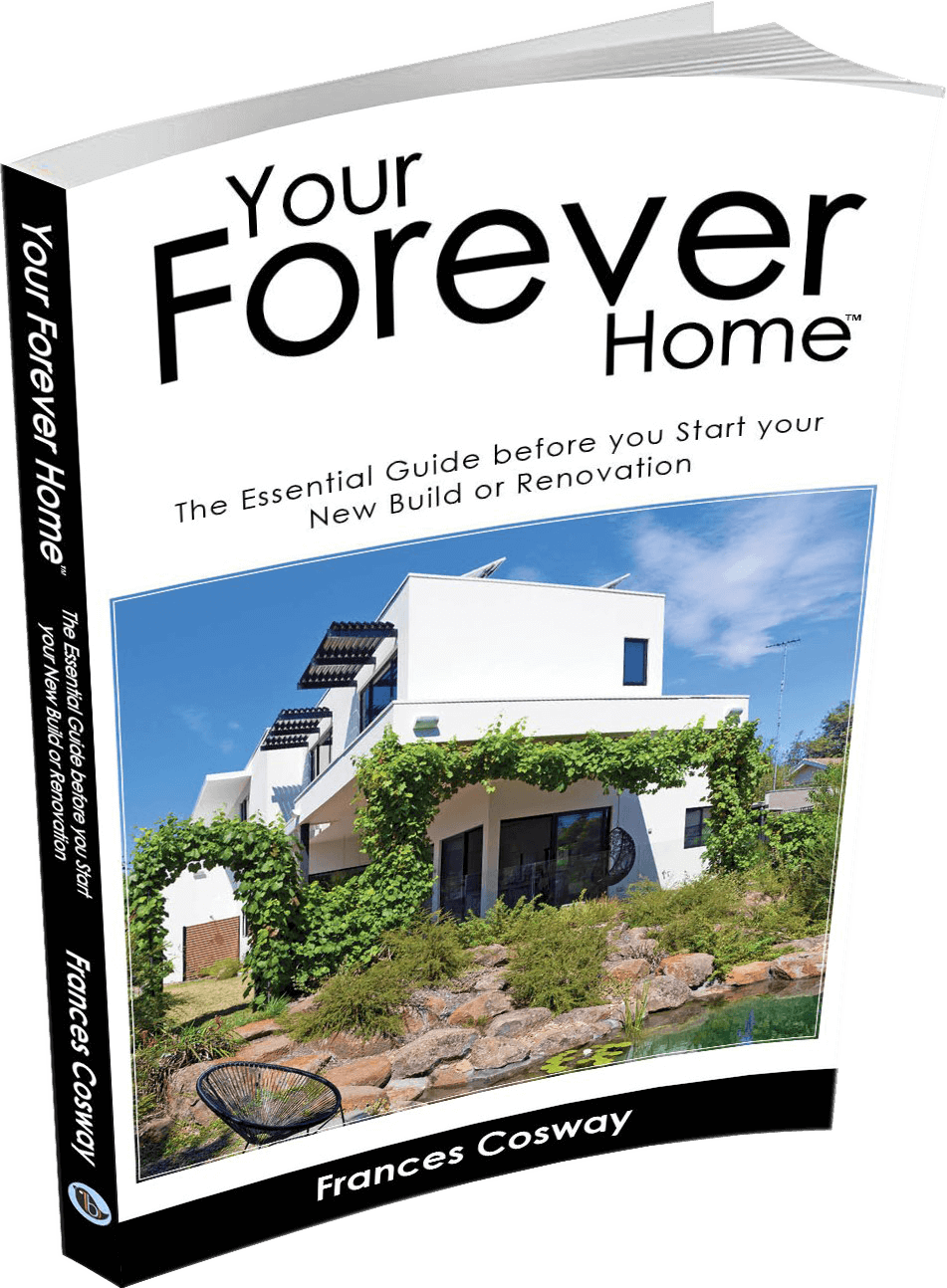In this special 3 part series ‘Designing and Building my Own Forever Home’, Frances will take you on her own Forever Home Journey. In this episode, Part 1 of the series, Frances outlines how she created the vision for her home along with how she researched and found her architect to design the home. This series is a wonderful insight, and personal story, warts and all, of how Frances designed and built her own Forever Home.
Episode 102: Designing and Building my Forever Home Part 1- The Vision and Finding an Architect

SHOWNOTES
Frances’ Vision of Designing and Building her own Forever Home
Frances and her family needed a bigger home to cater for their changing needs – growing kids and a growing business. They also wanted to move closer to the beach. And more importantly, they wanted to contribute to improving the environment by creating their own energy-efficient sustainable home.
Frances and her partner, Neil, created the possibility of being able to design a highly energy-efficient, sustainable, and comfortable home, that was also visually appealing.
Critical criteria before starting
Site Orientation & Size
For Frances, finding a site with the correct orientation was critical. She personally didn’t like West/East, nor South orientation. They were looking either at a north or west-facing garden that would allow her to see a beautiful view of the sunset in the evening.
The size of the land was also a strong consideration, and ideally wanted something more than 700sqm.
Location
It wasn’t just about being walking distance to the beach but also had to be walking distance to the local village, schools, and the train station.
The Process
In 2013, they found a site that also came with a very run-down home with no redeemable features, so the only real option was to knock down, design, and build.
Creating a brief
A. Written Brief
Their brief included:
- Energy efficiency goals and requirements
- Minimum star rating
- Had to meet local council planning regulations so they don’t need a planning permit
- Designed to the orientation of the site
- Outdoor requirements such as pool, veggies, and trampoline
B. Pictorial Brief
Frances had a folder of all the images of houses that she and her partner love. Their aspirational dream home is the Kaufmann House in Palm Springs
C. Landscape Brief
An Australian Native Garden and other plants that are indigenous to the area.
- Veggies
- Grassed area for the kids to play
- Space for the trampoline
- Additional energy efficiency consultants
- Modeling how to increase the star rating
- Blower tests to measure air leakage in the home
Finding the architect
Finding an architect was a real challenge because of the specific energy efficiency requirements.
Process to find designer
- Formulated a set of questions to ask the architects, particularly around how they design for energy efficiency.
- A few key questions allowed them to know if knowledge was sufficient to design beyond the ‘norm’ on energy efficiency.
- Interviewed 6 architects and selected one based on solid energy efficiency knowledge yet wasn’t as creative as some of the others.
- Had they been building their home in 2021 and not 2013, the skills and expertise that have evolved over this time have meant that there are a lot of choices available now than then, and many compromises had to be made in 2013 due to lack of expertise and availability of materials.
Becoming a qualified passive house consultant
Neil did a lot of research on options for rain catchment, new technologies, and materials coming into Australia, inground tanks, solar panels, and in the end, he became a qualified passive house consultant.
His knowledge allowed them to challenge the status quo and bring in new technologies and materials that otherwise would not have been specified.
Budget
They knew from the outset that they would focus their budget on getting the structure of the build right for maximum energy efficiency (eg, items not able to be retrofitted). This focused on the bones of the building (insulation, windows, materials).
They had to ensure that they could build the most energy-efficient house within their budget. So, they opted to save money on the interiors and areas that could be changed later.
Selling the current home unexpectedly
Partway through the design phase, plans changed and the current home they were living in had to be sold, which was not part of the plan.
It turned out it created an unexpected windfall, and meant they were able to install some special extras they would not have been able to, had the current home not been sold prior to the build completion.
Key takeaways
Things will be thrown at you during the design and build that is not part of your plan, however, these may work to your advantage. Find and see curve balls that are thrown your way as opportunities as it may give you a better outcome.
Stick to your core values. Frances and her family wanted to make a difference on the planet and be able to create something that they are proud of. So even with limited options, they pushed through with their goal and that is to create an energy-efficient home.
Resources available:
Download this FREE guide- How to Find your Renovation or New Build Team as this gives you the checklist and process on how you find the right people for your team.
Want peace of mind that your floorplan is as good as it can be? For a small investment, make sure your floor plan is going to be functional and flexible for lasting peace of mind.
A Floor Plan Sanity Check™ can reduce the need for major structural changes down the line and save you thousands.
Find out more and book directly here – https://www.whitepebbleinteriors.com.au/floor-plan-sanity-check-booking-form/




